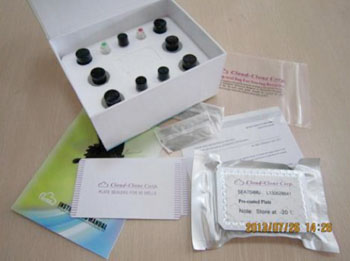Preeclampsia Biomarker Detected Very Early In Pregnancy
By LabMedica International staff writers
Posted on 24 Jul 2014
A biomarker has been discovered that could give expecting mothers and their doctors the first simple blood test to reliably predict that a pregnant woman may develop preeclampsia, at least as early as six weeks into the pregnancy.Posted on 24 Jul 2014
Preeclampsia, a cardiovascular disorder of late pregnancy, is characterized as a low-renin hypertensive state relative to normotensive pregnancy, and other non-pregnant low-renin hypertensive disorders often exhibit and are occasionally dependent on elevated arginine vasopressin (AVP) secretion.

Image: Enzyme-linked immunosorbent kit (ELISA) specific for human copeptin (Photo courtesy of USCN Life Science).
Scientists at the University of Iowa (Iowa City, IA, USA) measured copeptin levels throughout pregnancy in maternal plasma from preeclamptic and control women. A total of 54 control pregnant, non-preeclamptic women, 50 pregnant, preeclampsia women, and 33 non-pregnant women were included in the study. Maternal plasma copeptin is an inert, stable biomarker of vasopressin secretion with a substantially longer half-life in the blood than vasopressin.
All maternal plasma copeptin concentrations were measured in duplicate using a commercial enzyme-linked immunosorbent assay (ELISA) specific for human copeptin (USCN Life Science, Inc.; Houston, TX, USA). The minimum detectible dose of human copeptin for this assay was 5.4 pg/mL. To examine if renal function or AVP degradation throughout pregnancy affected copeptin concentration, plasma Cystatin C (Sigma-Aldrich, St. Louis, MO, USA) and USCN Life Science’s vasopressinase were measured in duplicate in all samples utilizing commercial ELISA kits.
Maternal plasma copeptin concentration is significantly higher in pregnant women who developed preeclampsia in comparison with control, non-preeclamptic women in the first, second, and third trimesters. In addition, the trimester-specific copeptin concentrations in preeclamptic women are higher than the plasma copeptin concentration of non-pregnant women. The authors concluded that measurement of AVP release in the first few weeks of pregnancy holds great promise as a novel diagnostic tool to predict the development of preeclampsia, and the inhibition of AVP release or action may represent a novel and rational therapeutic approach in preventing and treating preeclampsia.
Justin L. Grobe, PhD, the senior author of the study, said, “We've broken the circle of 'no test, no model, no cure' which has plagued the preeclampsia field for centuries. Suddenly we have identified a hormone that is elevated well ahead of the disorder, and have demonstrated that this hormone can cause the symptoms. It is only a matter of time before we can therapeutically target this system as a preventative or curative intervention.” The study was published on July 7, 2014, in the journal Hypertension.
Related Links:
University of Iowa
USCN Life Science
Sigma- Aldrich













